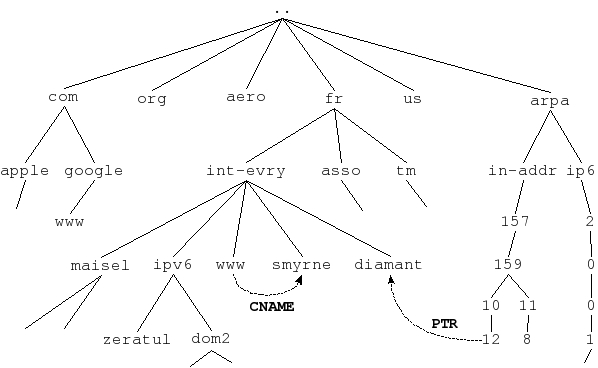
Naming scheme is similar to Unix filesytem naming except for
reverse notation (ends with root).
DNS Names are used as index in Data Base.
Root is "worldwide" unique, and so the DNS tree refers to
a global Data base.
Each Node is identified by a label of size 0 to 63 bytes,
empty label (0 bytes) is reserved for the root node.
Labels are CaSEInsenSITiVe
Any 8bits character can be used in labels ("." included) without
restrictions from the DNS itself.
On the other hand, some applications
using DNS can introduce restrictions on labels. For instance, SMTP (mail)
defines in RFC2822 a restricted syntax for DNS labels used as
email addresses (Record MX). In this case, labels must be conform
to the following BNF syntax :
<domain> := <subdomain> | " " <subdomain> := <label> | <subdomain> "." <label> <label> := <letter> [ [ <ldh-str> ] <let-dig> ] <ldh-str> := <let-dig-hyp> | <let-dig-hyp> <ldh-str> <let-dig-hyp> := <let-dig> | "-" <let-dig> := <letter> | <digit> <letter> := "a" | ... | "z" | "A" | ... | "Z" <digit> := "0" | ... | "9"
Domain Name = path from any node to the root in the DNS tree.
Identified by successive labels with dot character as separator.
Maximum size for a domain Name is 255 octets ("." included)
Without a final dot, a Domain Name becomes relative to
a "current" domain. For instance, inside INT www can be used
as alias for www.int-evry.fr., assuming int-evry.fr.
as the default domain. In practice, we also use www.int-evry.fr
in place of www.int-evry.fr. assuming root domain as the default one,
but www.int-evry.fr.int-evry.fr. could be another well-founded
interpretation.
A domain name with the final dot is called FQDN (Fully
Qualified Domain Name).
Formally, a DNS Domain is defined as the complete sub-tree attached to any node in the DNS tree. The domain name for the root of the sub-tree is used to identify the DNS Domain. The common usage is to exclude leaves from the definition of DNS Domains, but technically the DNS system doesn't distinguish between internal nodes and leaves. For instance : www.int-evry.fr. is a leaf, it becomes a Domain if the name example.www.int-evry.fr is created and it could be done without any modification of the node www.int-evry.fr. in the DNS system.
An host can be named with more than one DNS name, may be in different
domains. Naming scheme is logical and so fully independent of the network
topology (except for reverse DNS).
Naming scheme is defined for indexing the DNS Data Base, but is also
used to realize a responsibility delegation in the distributed management
of the DNS system.
Each node can be managed autonomously by different administrators.
The node administrator is responsible for creation or modification
of DNS names directly attached to the node, and for delegation of sub-domains
under the node.
NB: In fact, delegation doesn't operate on DNS domains but on DNS zones (to be viewed later)
The DNS tree structure can be extended with some mechanisms similar to symbolic links in UNIX filesystems :

First level nodes in the DNS tree are called TLD (Top Level Domain). These nodes are "co-managed" by IAB/IANA, INTERNIC, and ICANN. (cf. WWW.ICANN.ORG etWWW.INTERNIC.ORG.)
Examples : US. United States, FR. France, TV. Tuvalu, VA. Vatican ...
Exceptions :
"French" ccTLDs : FR. France, GF. Guyane, GP. Guadeloupe, MQ. Martinique, NC. Nouvelle calédonie, PF. Polynésie Française, PM. St. Pierre et Miquelon, RE. La Réunion, TF. Terres Australes Françaises, WF. Wallis et Futuna, YT. Mayotte,